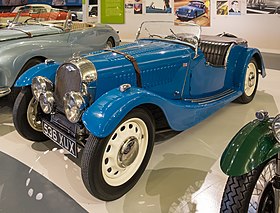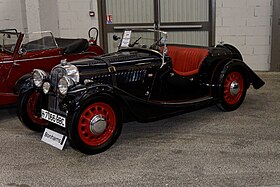
The Lotus Elise is a two-seat, rear-wheel drive, mid-engined roadster conceived in early 1994 and released in September 1996 by the British manufacturer Lotus Cars. The Elise has a fibreglass body shell atop its bonded extruded aluminium chassis that provides a rigid platform for the suspension, while keeping weight and production costs to a minimum. It is capable of speeds up to 240 km/h (150 mph). The Elise was named after Elisa Artioli, the granddaughter of Romano Artioli who was chairman of Lotus and Bugatti at the time of the car's launch.
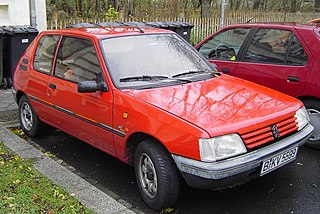
The Peugeot 205 is a supermini (B-segment) car produced by the French manufacturer Peugeot from 1983 to 1999.

The Lotus Europa name is used on two distinct mid-engine GT cars built by British automobile manufacturer Lotus Cars. The original Europa and its variants comprise the Lotus Types 46, 47, 54, 65 and 74, and were produced between 1966 and 1975.

The Morgan Motor Company is a British motor car manufacturer owned by Italian investment group Investindustrial. It was founded in 1910 by Henry Frederick Stanley Morgan. Morgan is based in Malvern Link, an area of Malvern, and employs approximately 220 people. Morgan produce 850 cars per year, all assembled by hand. The waiting list for a car is approximately six months, but it has sometimes been as long as ten years.
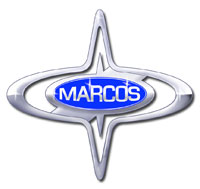
Marcos Engineering was a British sports car manufacturer. The name derives from the surnames of founders Jem Marsh and Frank Costin.

The SEAT León, also spelled Leon in some other languages, is a hatchback compact car built by the Spanish car manufacturer SEAT since October 1999.
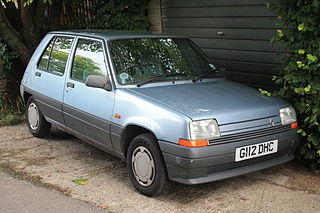
The Renault 5 is a five-passenger, three or five-door, front-engine, front-wheel drive hatchback supermini manufactured and marketed by the French automaker Renault over two generations: 1972–1985 and 1984–1996. The R5 was marketed in the US and Canada as Le Car, from 1976 until 1983. Renault marketed a four-door sedan variant, the Renault 7, manufactured from 1974 until 1984 in Spain by Renault's subsidiary FASA-Renault and exported to select markets.

The Audi 80 is a compact executive car produced by the Audi subdivision of the Volkswagen Group across four generations from 1966 to 1996. It shared its platform with the Volkswagen Passat from 1973 to 1986 and was available as a saloon, and station wagon — the latter marketed by Audi as the Avant. The coupé and convertible models were not badged as members of the range but used a derivative of the same platforms.

Berkeley Cars Ltd of Biggleswade, Bedfordshire, England produced economical sporting microcars with motorcycle-derived engines from 322 cc to 692 cc and front wheel drive between 1956 and 1960.

The Lotus Exige is a British two-door, two-seat sports car made by Lotus Cars since 2000. Originally a more-hardcore coupé version of the Lotus Elise roadster, since the Series 3 the Exige has been the larger-engined model of the family - using a V6 engine in place of the Elise's straight-four with convertible versions of both available.

In automotive engineering a multi-valve or multivalve engine is one where each cylinder has more than two valves. A multi-valve engine has better breathing and may be able to operate at higher revolutions per minute (RPM) than a two-valve engine, delivering more power.

The Peugeot 404 is a large family car produced by French automobile manufacturer Peugeot from 1960 to 1975. A truck body style variant was marketed until 1988. Styled by Pininfarina, the 404 was offered initially as a saloon, estate, and pickup. A convertible was added in 1962, and a coupé in 1963. The 404 was fitted with a 1.6 litre petrol engine, with either a Solex carburetor or Kugelfischer mechanical fuel injection or a 1.9 litre diesel engine available as options. Introduced at the Paris Motor Show as an option was the inclusion of a 3-speed ZF automatic transmission, similar to the unit already offered on certain BMW models, as an alternative to the standard column-mounted manual unit.

The Sunbeam Rapier is an automobile produced by Rootes Group from 1955 until 1976, in two different body-styles, the "Series" cars and the later (1967–76) fastback shape, part of the "Arrow" range.
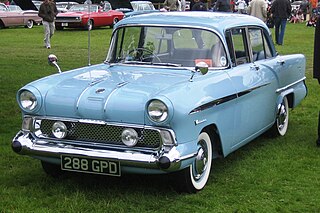
The Vauxhall Victor is a large family car produced by Vauxhall from 1957 until 1976. The Victor was introduced to replace the outgoing Wyvern model. It was renamed Vauxhall VX Series in 1976 and continued in production until 1978, by which time it had grown significantly and was viewed, at least in its home market, as a larger-than-average family car.

The MGA is a sports car that was produced by MG from 1955 until 1962.

The Vauxhall Cresta is a British automobile which was produced by Vauxhall from 1954 to 1972. The Cresta was introduced in 1954 as an upmarket version of the Vauxhall Velox, itself a six-cylinder version of the Vauxhall Wyvern. The Cresta models were the E (1954–1957), PA (1957–1962), PB (1962–1965) and PC (1965–1972). The Viscount (1966–1972) was an upmarket Cresta PC.

The Ford Escort is a small family car that was manufactured by Ford of Europe from 1968 until 2000. In total there were six generations, spread across three basic platforms beginning with the original rear-wheel drive Mk.1/Mk.2 (1968–1980), the "Erika" front wheel drive Mk.3/Mk.4 (1980–1992), and the final CE-14 Mk.5/Mk.6 (1990–2002) version. Its successor - the Ford Focus - was released in 1998, but the final generation of Escort was gradually phased out, with the panel van version ending production in 2002 in favour of the Ford Transit Connect.

The Škoda Rapid is a fastback coupé designed and built by AZNP in Czechoslovakia between 1984 and 1990. Based on the rear-engined Škoda 105 120 and 130 saloon, it was a replacement for the Škoda Garde coupe built between 1981 and 1984 itself based upon the Škoda 105/120 sedan design, which was also called the Rapid in the UK market. Some Garde/Rapid cars were sent to Ludgate Design & Development in Kent, United Kingdom, by Škoda to be converted into convertibles.

The Reliant Scimitar SS1 is an automobile which was produced by British manufacturer Reliant from 1984.

Volkswagen R is the brand used by the German auto manufacturer Volkswagen to indicate a sport or high performance model. An "R" badge is placed on the grille, front fenders and trunk of R-model vehicles to indicate the vehicle's trim level.
